The Raleigh Cycle Co, Nottingham
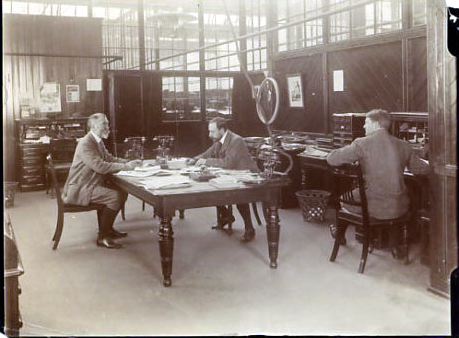
1900: FRANK BOWDEN of Raleigh on the left
The history of The Raleigh Cycle Co offers an excellent insight into the history of cycle manufacturing in Great Britain. And for those of us who collect ‘old black bikes’ Raleigh provided a wonderful supply and variety. A Raleigh Superbe is surely the most practical vintage bicycle to own and use on a regular basis.
Comprehensive records of Raleigh frame numbers is another very useful factor: you can check the age of your Raleigh at the bottom of this page.
The list below is one I’ve used over the years, when buying vintage bicycles, to remember when those companies were still ‘original’ before being taken over by Raleigh:
Humber 1932
Rudge-Whitworth 1943
Triumph 1954
Three Spires 1954
BSA , New Hudson, Sunbeam 1957
Phillips 1960
Hercules 1960
Norman 1960
Sun 1960
Carlton 1960
*********************
Raleigh Street, Nottingham, was the site of a small workshop which in 1886 started producing diamond-frame safety bicycles at the rate of three a week. Frank Bowden, a successful lawyer and convert to cycling, bought the firm in 1887 and in December 1888 founded The Raleigh Cycle Company as a limited liability private company. It grew rapidly and within a few years was a large public company capitalised at £100,000 (equivalent to about £5m today).
In 1902, Sturmey-Archer gears were added to the product range. Six years later, Bowden bought back Raleigh, which was to remain in family hands for the next quarter century. By the early 1920s, Raleigh was a world leader, capable of producing annually 100,000 cycles, 250,000 hub gears 15,000 motorcycles and 50,000 motorcycle gearboxes.
Raleigh survived the Great Depression well. It acquired Humber cycles in 1932 and the following year started producing a three-wheeler car. In 1934 Raleigh reverted to public company status, as Raleigh Cycle Holdings Ltd, with a share issue of more than £2m (= about £65m today). By 1938, its production of bicycles had grown to nearly 500,000 units per annum and the company had stopped making motorcycles and cars.
During the Second World War (1939-45), Raleigh concentrated on munitions work. The name of its budget range, launched in 1938 as Gazelle, was changed to Robin Hood, and Raleigh acquired Rudge-Whitworth.
After the war, despite shortages of fuel and steel, Raleigh’s cycle production rose rapidly. By 1949, it had reached about 750,000, the majority of which was exported.
***********************
In 1951, Raleigh produced more than a million cycles. But between 1950 and 1962, as increasingly prosperous consumers abandoned the cycle in favour of the car, cycle sales in the UK halved. This led Raleigh in 1958 to resume moped production and later to launch a motor scooter. More significantly, during this period Raleigh acquired two major rival groups: Triumph and Three Spires in 1954, and BSA (including New Hudson and Sunbeam) in 1957.
Raleigh itself was then taken over by Tube Investments (TI), whose British Cycle Corporation owned Phillips, Hercules, Norman and Sun. The effect of these mergers was that Raleigh’s sales figures showed a slight upward trend during most of the 1950s.The TI take-over followed a collaborative venture with Raleigh in South Africa. In 1960, TI bought all Raleigh shares, then handed over the British Cycle Corporation to Raleigh management. Suddenly, TI-Raleigh had 75% of the UK market. Unfortunately, it was a market that was rapidly shrinking.
In spring 1960 Raleigh, having stopped making quality lightweight cycles at Nottingham, bought Carlton Cycles, a respected hand-built racing cycle specialist company based nearby at Worksop.
Raleigh urgently needed to increase volume sales to the man and woman in the street. In October 1960, a licensing agreement was drawn up allowing Raleigh to make the new, small-wheeled, unisex, dual-suspension Moulton bicycle. Production was scheduled to commence in November 1961 but in September, Raleigh imposed a moratorium: Leslie Roberts, Raleigh’s incoming managing director, did not believe the Moulton could yield a reasonable profit.
Alex Moulton therefore built his own factory and started delivering Moultons to the trade in March 1963. The new machine was an immediate success, and most production had to be farmed out to Fisher & Ludlow, a subsidiary of the British Motor Corporation.
In March 1964, Raleigh showed Moulton the prototype RSW16: an unsprung small-wheeled shopping bike that was well equipped, more robust and cheaper than the Moulton. It was unclear whether the RSW breached Moulton’s patents and in June 1964 Raleigh sought a production licence for the Moulton bicycle. Alex Moulton was prepared to licence an unsprung F-frame small-wheeler, provided the genuine Moulton could be sold through Raleigh dealers. Negotiations continued into the autumn of 1964 and included the possibility of Raleigh buying the Moulton cycle operation outright, or Raleigh buying Moulton bicycles badged as Raleighs, or Raleigh taking over Moulton’s marketing. None of these options came to fruition.
By mid 1965, Moulton was producing more than 1,000 units a week. The new cycle, and the interest it created in cycling as a stylish, modern and practical mode of transport, had arrested the steep post-war decline in UK cycle sales. However, Raleigh was seeing little benefit, except from the Sturmey-Archer hubs it sold to Moulton. Indeed, since the TI take-over, Raleigh’s sales had dropped by a staggering 49%. In addition, other cycle makers such as Dawes and Royal Enfield were introducing small-wheelers to cash in on the Moulton boom. Therefore, in July 1965, Raleigh launched the RSW16 with an unprecedented £100,000 of publicity (= more than £1m today).
The RSW16 proved commercially successful, going into MkII and MkIII versions and selling more than 100,000 units in its nine-year production run. Scaled-down juvenile versions, such as the RSW14, also sold well. However, the Wisp, a moped based on the RSW16 and launched in spring 1967, proved a commercial failure.
Launch of the RSW sparked a trade war between Raleigh and Moulton. By 1967, both were suffering. Despite a 40% increase in sales since launch of the RSW16, Raleigh’s profits for the previous year were down 8% and Moulton was losing money unsustainably. In late July 1967, Moulton Bicycles Limited was bought by Raleigh, who retained Alex Moulton as a consultant.
In 1968, but with relatively little publicity, Raleigh introduced the Twenty. This long-lived H-frame small-wheeler was destined to become for a while the company’s biggest selling model and remained in production for some 16 years. At one time or another, it was sold under almost every brand name owned by Raleigh.
Above text taken from ‘the unabridged and updated version of a paper written by Tony Hadland in June 2000 for the 11th International Cycle History Conference held at Osaka in August 2000.’ http://homepage.ntlworld.com/catfoodrob/choppers/history/history1.html
*****************************
Raleigh of Nottingham was for many decades the worlds leading manufacturer of bicycles. Here are some of the high points of a more than a century of bicycle manufacture.
1886 – Three Englishmen – Woodhead, Angois and Ellis – begin building bicycles in a small workshop on Raleigh Street, Nottingham.
1887 – Alfred Milward Reynolds invents the process of butting (of tubes).
1887 – The Raleigh Cycle Company – Russell Street.
1888 – Frank Bowden purchases the Woodhead/Angois/Ellis bicycle workshop on Raleigh Street and renames it the Raleigh Cycle Company. At this point there are about a dozen employees and production is three high-wheelers a week.
1889 – Reynolds founds the Patented Butted Tube Company.
1895 – British stockbroker Terah Hooley buys controlling interest in Raleigh.
1896 – Fred Hanstock builds the first Carlton bicycles in Carlton, England.
1896 – Raleigh has the world’s largest bicycle factory, occupying 7 1/2 acres. There are about 850 employees and production is 30,000 units per year.
1900 – ‘The All-Steel Bicycle’.
1902 – Raleigh buys Sturmey-Archer.
1904 – Raleignette.
1905 – Motor Cycles produced.
1906 – Robin Hood Cycle Co Ltd acquired.
1914 – Over 50,000 cycles produced.
1914-1918 – 400 Million parts for Forces (Munitions).
1920 – The Nottingham presswork acquired.
1921 – Sir Frank Bowden died.
1921 – Motor Cycle Production resumed.
1923 – Patented Butted Tube Company name is changed to Reynolds Tube Company, Ltd.
1925 Factory increased to 20 acres.
1928 – 114,072 cycles produced.
1931 – H O opened Lenton Boulevard.
1930s – Carlton bicycle factory moves to larger facilities in Worksop, England.
1931-1936 – Safety Seven Car.
1932 – Raleigh buys Humber Cycles.
1934 – Raleigh Industries Ltd.
1935 – Reynolds 531 manganese-molybdenum (”mang-moly”) tubing is developed.
1936 Motorised production ceased.
1937 Invention of the Sturmey-Archer Dynohub.
1938 – Raleighs first exported to Canada.
1939 – 409,479 cycles produced.
1939-45 – WW2 Munitions production.
1943 – Raleigh buys Rudge-Whitworth.
1943 – Gradual Payments (Nottm Ltd) acquired.
1946 – Factory increases to 28 acres – 5,000 Employees.
1946 – ‘Winkle’ tricycle – first of the toy range.
1947-1948 – Boston USA Plant-Ral. Ind. of America Inc.
1949 – Raleigh Industries of India Ltd.
1950 – Raleigh Industries of South Africa Ltd.
1951 – 1,010,077 Cycles produced.
1952 – Duke of Edinburgh opens New Factory – Now 40 acres, 7,000 Employees.
1953 – Raleigh buys the Triumph Cycle Company.
1955 Raleigh Cycles Industries of Canada Ltd.
1957 – Raleigh buys BSA (Birmingham Small Arms).
1958 – First mopeds produced (Raleigh Mo-ped, later known as the RM1).
1960 – Raleigh and the Tube Investments Group (aka TI) merge, forming TI Raleigh.
1965 – RSW 16
1967 – Moulton Cycles acquired.
1967 – Cox of Watford acquired.
1968 – Queen Elizabeth II visits Raleigh.
1969 – Dreamline range of Prams/Pushchairs.
1970 – Chopper (U K)
1970 – Production ceased motorised products.
********************
Determining the Age of a Raleigh
Note that the serial number information below is fragmentary and incomplete, and many bikes have proven to be much newer than the serial numbers would suggest. It appears that Raleigh recycled many of the older serial numbers in later years, so there are lots of bikes from the 60s and 70s that have serial numbers that would suggest much greater age.
1888-1925
Prior to 1925, genuine Raleighs (not necessarily brand names made by Raleigh) had a straightforward numerical frame number. Early years have been estimated by the Company. (Info from the Nottinghamshire Archives)
Note that the serial number information below is fragmentary and incomplete, and many bikes have proven to be much newer than the serial numbers would suggest. It appears that Raleigh recycled many of the older serial numbers in later years, so there are lots of bikes from the 60s and 70s that have serial numbers that would suggest much greater age.
1888: 1500
1889: 3200
1890: 5200
1891: 7600
1892: 10500
1893: 13900
1894: 19100
1895: 25300
1896: 32100
1897: 39913
1898: 45981
1899: 54032
1900: 65152
1900: 69868
1901: 77342
1902: 89622
1903: 102954
1904: 112673
1905: 129228
1906: 154917
1907: 183073
1908: 215650
1909: 249081
1910: 285669
1911: 328748
1912: 375693
1913: 427829
1914: 482851
1915: 517198
1916: 545198
1917: 569737
1918: 592473
1919: 621678
1920: 654502
1921: 688291
1922: 738447
1923: 809184
1924: 899465
1925: 998077
1925-Second World War
Between 1925 and the cessation of cycle production during the Second World War, letters prefixed or suffixed the running frame number although no indication is given of the starting point of the numbers. They seem to reflect only the number of machines produced whilst each letter was in use. All dating would therefore be approximate. (Info from the Nottinghamshire Archives)
1925: A1
1925: B34181
1926/27: B56536
1929: E15693
1930: G94785
1933: L84682
1934: T93945
1934: U14540
1935: W71147
1936: W93161
1937: Y184552
Post Second World War – 1955
After the war, Raleigh began adding letters after the running number series which restarted when a new letter was used. (Info from the Nottinghamshire Archives)
1947: 437689 P
1948: 556894 P
1949: 695051 P
1951: 151179 T
1952: 236530 T
1953: 367369 T
1954: 566722 T
1955: 747951 T
1956: 852312 T
1957: 872584 T
1955 – 1966
A new numbering system was introduced in 1955, though this ran concurrently with the old one for two years. The new system involved a second running letter, added to the first, which began at the start of the alphabet.
1956: 23839 A
1957: 27227 AB
1958: 17910 AD
1960: 27273 AE
1961: 13126 AF
1965/6: 40814 FD
1966: 64521 FE
Note: Some of the mid-60’s straight guage 531 frames had serial numbers starting with a single letter which was towards the end of the alphabet.
1967 – 1973
Yet another number system was introduced in 1966. This new system applied to the high-end (i.e. Reynolds 531) frames, and involved the placing of a character at the beginning of the serial number. The character began at the start of the alphabet, and indicated year of manufacture. Detail about the numerals that follow the alphabet are sketchy, and are presumably sequential serial numbers of some kind.
1966: A, followed by four numerals
1967: B, followed by four numerals
1968: C, followed by four numerals
1969: D, followed by four numerals
1970: E, followed by four numerals
1971: F, followed by four numerals
1972: G, followed by four numerals
1973: H, followed by four numerals
Note: While this numbering scheme is generally true, there may have been some crossover use of letters at the beginning/end of each year (e.g. a “G” serial number may have been built into a bike in 1973, but the frame may have been built in 1972).
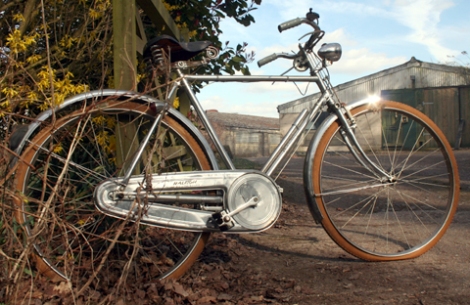
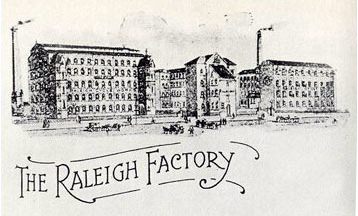
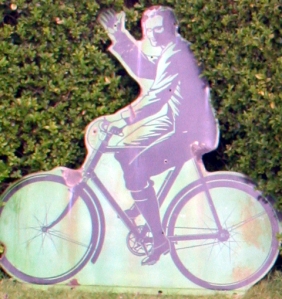
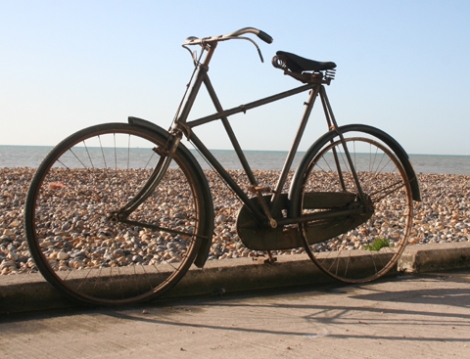
You must be logged in to post a comment.